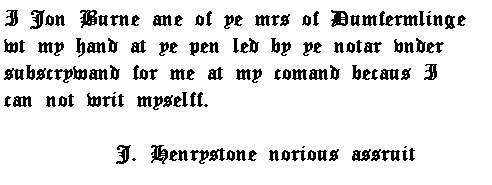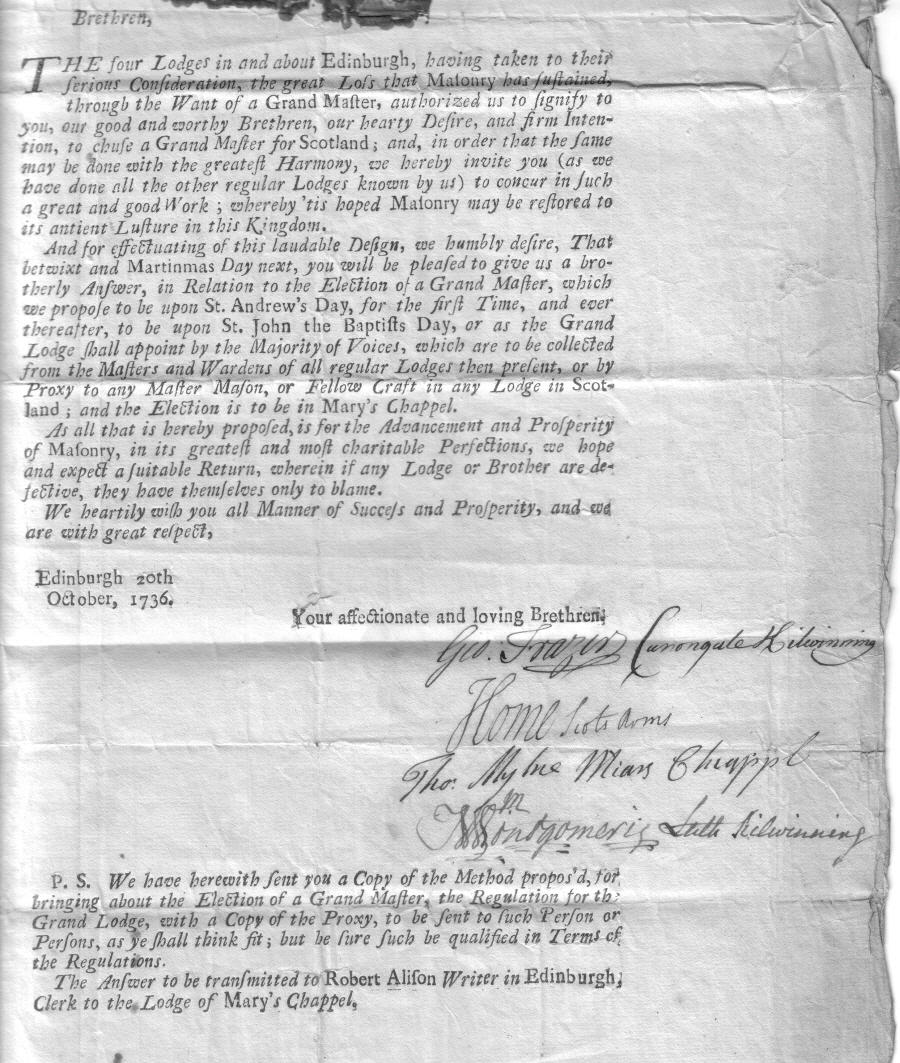

St. Clair Charters
The oldest record in possession of the Lodge is dated 27th December 1698, but there is ample evidence that the Lodge was in existence long before that date. The St Clair Charters in the possession of the Grand Lodge of Scotland were drawn in favour of William St Clair of Roslin, and are dated 1598 and 1628, the earlier one was signed by ROBERT PEST, Dumfermling, and the latter as follows :-
The original name of the Lodge was "The Ludge of the Masons of Dunfermling."
From 1698 until 1734 the Presiding Office-Bearer was named the Deacon (who also officiated as Treasurer). Only, one Warden was elected, and the only, other Office-Bearer named in the records was the Clerk.
The earliest reference to the use of tools is dated 8th January 1701, and is in the following terms:-
"James Somervaill did gift to the Ludge ane brass square for the use of the Ludge,
for which gift the Quorum above namit quits his sons enterie money, being Six Ponds, and ordain the Deacon to be discharged theirof.
INSTITUTION OF GRAND LODGE.
On 20th October 1736 the four Lodges in and about Edinburgh, namely, Mary's Chapel, Canongate Kilwinning, Kilwinning Scots Arms, and Leith Kilwinning, sent a circular to all the Lodges in Scotland inviting them to send representatives to elect a Grand Master. The election took place on the 30th November, the Lodge being represented by Captain Arthur Forbes of Pittencrieff (Master), and Baillie Charles Chalmers and Henry Findly (Wardens).
The earliest record of the Lodge desiring to erect a Lodge Room of its own is shown in the following Minute:-
ST J0HN'S DAY, 27th December 1732.
.... "The Ludge also impowers the said Committee to seek out for a piece of ground in Dunfermline that they think most proper for building a house for the use of the Ludge, and to buy the said piece of ground, and raise as much of the Ludge money as will pay the price of it, or grant bond for the price, which of them they shall think meet, and generally every other thing thereanent to doe as fully in all respects as if the Ludge were there present."
19th March 1733.'
The Sub-Committee agreed with Mr George Adie, preacher of the Gospell at Dunfermline, to pay him three hundred merks for his ruinous tenement on the south side of the Maygeat of Dunfermline. Accordingly, Mr Adie delivered to the Sub-Committee a signed disposition of the sd tenement with the consent of his mother, and the Deacon gave bill to him, for the price payable St Johns day next, including five pounds of annual rent from Whitsunday next, extending in whole to Two Hundred and five Pounds Scots.
Another historical point of interest about our Lodge can be viewed on this link on the Grand Lodge Of Scotland website.
LODGE ST. JOHN, DUNFERMLINE, No. 26.
In terms of Freemasonry, Lodge St. John is ancient. It connects directly with "the Ludge of Masons of dunfermling" which held ,St. Clair Charters in 1598 and 1628. It doubtless existed prior to these dates, which gives a fair assumption that it played a part in the addition to, Dunfermline Palace (1540). The earliest record in possession of the Lodge is dated 1698. At the meeting in Edinburgh on 30th November l736, when Grand Lodge was formed, the Lodge had three representatives, Captain Arthur Forbes of Pittencrieff (Master), Bailie Charles Chalmers, and Henry Finlay (Wardens), and was of course, in the original province of Fife, when formed in 1745. Interesting notes bearing on its antiquity are contained in a booklet issued in connection with the opening, of their new hall in Priory Lane (a Lodgeroom in excellent. taste) which was consecrated by the P.G.M., the Earl of Elgin and Kincardine, on 17th December 1920, The hall is at present in use for national purposes making it difficult to gain access to old records. From the information available, the Secretary informs us that the date of the present Charter is 1766; that an early meeting place was the Spire Tavern c, 1814, and that the first R.W.M. was Lieut. Charles Durie. Special gifts to the Lodge include the Master's Chair from the Earl of Elgin; set of working tools from James C, Craig, and a brass square from Arnold Ramsay. Honorary members comprise Major P1ayfair, Elgin's Lodge; John Russell, Lodge Union; Andrew Barnard No. 815; Joseph Inglis, Canongate; James Gibson, No. 1; The Earl of Elgin, Elgin and Bruce; Sir Alexander Gibb Elgin and Bruce.


Below is a copy of our invitation to a meeting to form the Grand Lodge of Scotland




